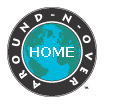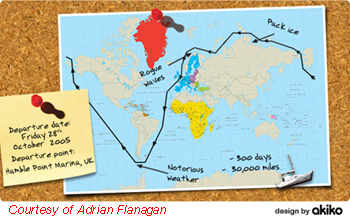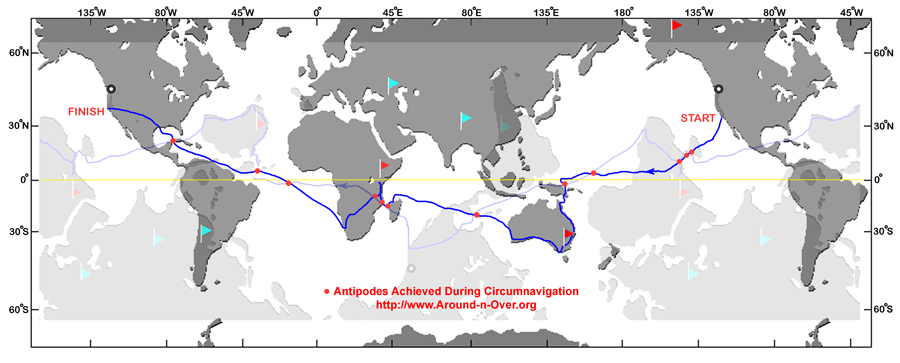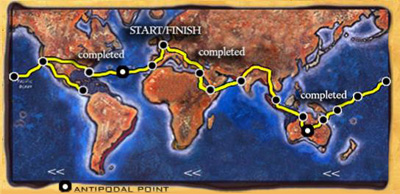 |
| About us |
| Education Portal |
| The Team |
| Our Projects |
| Our Score Card |
| Partners |
| Sponsors |
| Media Coverage |
| Media Kit |
| Shopping Helps |
| Support us |
| Contacts |
 |
Six Summits Expedition has already achieved a human powered circumnavigation:
What's so special about this very unique word? A basic definition of a world circumnavigation is an around the world journey on a route which:
The implications from the above descriptions are that a true circumnavigation route:
Antipodes: Pairs of points on earth which are antipodes, are located diametrically opposite of each other. Every point on earth has its own antipode. The North Pole for example, is the natural antipode of the South Pole. This link provides a visual tool to find your antipode. Great Circle: The center of a great circle is the same as that of the earth. For example, the longitudes are on great circles, and the Equator is the latitude which defines the longest great circle given the earth's shape. Other lines of latitude which are shorter are not great circles, because their centers do not match that of the Earth. Great circles divide the earth into two equal hemispheres. Following a great circle path is not practical for surface journeys thus, a true circumnavigation will approximate a great circle by complying with the antipodal requirement. AdventureStats rules do not distinguish between an around-the-world surface journey and a circumnavigation. They are treated as one and the same, requiring the journey to cover a minimum distance of 40,000km or 21,600nm and to include a pair of antipodes. Solo Circumnavigation assembled by Richard Konkolski offers background on the evolution of the circumnavigation standards in sailing. According to Konkolski, after Sir Francis Chichester's Gypsy Moth IV in 1967 crossed two pairs of antipodes nonstop along the route, in 1971, the founding editor of the Guinness Book of Records Norris McWhirter published Chichester's precedent as a rule which prevented shortcuts from being taken. For over 20 years, since 1970s to early 1990s this or a similar antipode requirement was so posted in the marine records tables of the Guinness Book of Records by Nobby Clarke who was solo circumnavigation historian and Guinness Book marine records consultant. Later Richard Boehmer who specialized in multihulls, continued in cooperation with Guinness Book for some time after Nobby Clarke retired in 1990 from this activity. Guinness World Records, which is an independent arbiter of all records, requires that a human powered around-the-world surface journey must:
Guinness World Records has defined the rules for Fastest Circumnavigation by Bicycle requiring the route to pass through a pair of antipodal points. The unsupported record is held by Jenny Graham of Scotland (member of the Adventure Syndicate). Graham completed her attempt in October 2018 in a total of 124 days. She cycled the route solo and totally unsupported often sleeping rough in drainage ditches or behind bushes. The supported record is held by Mark Beaumont of Scotland, who completed the route accompanied by a motorized support vehicle in 78 days 14 hours, and 40 minutes. It must be noted that this record definition forces the riders to take plane rides across oceans and over countries with political or other turmoil. A summary of this class of effort is summarized on this Wikipedia page. Another British man Alastair Humphreys completed a unique circumnavigation journey. Alastair crossed the oceans by boating, and he bicycled while on land. By the time that he had returned back to İstanbul in September 2005 closing the knot, he had covered 69,000 km. Alastair chose to bicycle another 3,000 km all the way to England to conclude his journey. Karl Bushby (British) of Goliath Expedition started his journey on foot on November 1st, 1998 in the Chilean town of Punta Arenas. Karl walked north through South America, Central and North America, before crossing from Alaska into Siberia, using the semi-frozen Arctic waters of the Bering Strait. With this achievement, Karl and his partner Dimitri Kieffer became the first modern men to walk across the Bering Straits. Karl's journey will continue west through Siberia, down to Russia's southern border, across Asia and Europe. The finish will be (pending authorization) through the Channel Tunnel and into the United Kingdom. Karl's walk will be a "walk around-the-world" because his route crossed the Equator and Karl will have covered a distance of 36,000 miles in excess of the length of the Tropic of Capricorn. Should Karl go through the town of Irkutsk which is the antipode to his starting point Punta Arenas, then Karl will have achieved a "circumnavigation by walking." Precedent - Surface Travel (the hard way): Sir Ranulph Fiennes and his team successfully completed Transglobe in 1982 after over two years of work. Transglobe was the first polar circumnavigation by surface travel, touching the two poles of the earth, which are true antipodes by definition. The story of this journey is told in the book: "To the Ends of the Earth." This expedition did not even have to cross all meridians... Precedent - Surface Travel (sailing): Sailors typically navigate the interconnected bodies of open water around the world. Many prominent sailing races, including the Vendée Globe, leave from Europe, travel into the South Atlantic, then follow an easterly heading around Antarctica, clearing Cape of Good Hope (tip of South Africa), then Cape Horn (tip of South America) respectively, eventually returning back north to Europe. The World Speed Sailing Record Council requires that an "Around the World" sailing record claim must have crossed the Equator. Rule 26.1.a in "the courses offshore" section of the WSSRC Rules Book is quoted below: 
Precedent - Exclusively For Flights (ballooning): Due to meteorological laws, hot air or helium balloons are dependent on the prevailing winds in the atmosphere to travel around the world. The eastbound jetstream in the southern hemisphere is an example of such winds. Steve Fossett in his historic first around-the-world balloon flight in the summer of 2002, launched "Bud Light Spirit of Freedom" from Australia, drifting east over the Pacific, South America, South Atlantic and the Indian Ocean. His flight took him back across the same longitude he had started over Australia to be complete. The Fédération Aéronautique Internationale (FAI) has defined the around-the-world flight rules specifically for "Class A: Free Balloons" and "Class B: Airships," the latter of which includes blimps. When such a flight crosses all longitudes, covers a distance which is at least half that of the circumference of the equator, eventually crossing the same longitude where it started, then it is considered an around the world flight. Needless to say, these rules are exclusively for aerial journeys. FAI never uses the unique expression circumnavigation in its "around-the-world-flight" definition, and never pretends to offer this ruling for any other application (as in surface journeys). FAI has stated in writing that they will not take a position on records by surface travel. FAI does not enforce an antipodal requirement by this around-the-world flight definition, nor does it expect pilots to cross the equator, recognizing the climatological constraints.
|
|||||||||||||||||||||||||||||||||||||||||||||||||||||||||||||||||||||||||||||||||||||||||||||||||||||||||||||||||||||||||||||||||||||||||||||||||||||||||||||||
|
All Rights Reserved. |
|||||||||||||||||||||||||||||||||||||||||||||||||||||||||||||||||||||||||||||||||||||||||||||||||||||||||||||||||||||||||||||||||||||||||||||||||||||||||||||||

 Precedent - Surface Travel (human powered): The first human powered circumnavigation having met the antipodal requirement was completed by Jason Lewis (British) of
Precedent - Surface Travel (human powered): The first human powered circumnavigation having met the antipodal requirement was completed by Jason Lewis (British) of